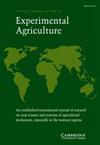Herbicide residues of pre-harvest burndown in cowpea bean (Vigna unguiculata) grains
IF 1.9
4区 农林科学
Q1 Agricultural and Biological Sciences
引用次数: 1
Abstract
Abstract Cowpea bean (Vigna unguiculata) is usually submitted to pre-harvest burndown with herbicides aiming to an early harvest. We aimed to quantify the residues of paraquat, diquat, glufosinate-ammonium and glyphosate in cowpea grains subjected to two timings of pre-harvest burndown. Three identical experiments were installed in Dourados (Lat. 22° S), Sinop (Lat. 11° S) and Teresina (Lat. 05° S), Brazil, comprising the pre-harvest burndown of cowpea bean with these herbicides, applied either with 50 or 75% of the pods dry and ready for harvest. As hotter and drier the location as slower the herbicide dissipation. Glyphosate should not be used for pre-harvest burndown of cowpea. Herbicide residues were above the maximum levels stated by the Brazilian legislation when applied with 50% dry pods. Burndown herbicides aiming to speed harvest should be applied with at least 75% dry pods in cowpea to ensure safe herbicide residue levels in grains.豇豆(Vigna unguiculata)收获前燃尽的除草剂残留
摘要豇豆(Vigna unguiculata)通常在收获前用除草剂焚烧,目的是提前收获。本研究旨在量化收获前两次焚烧豇豆籽粒中百草枯、双菊枯、草甘膦铵和草甘膦的残留量。在巴西的杜拉多斯(北纬22°S)、西诺普(北纬11°S)和特雷西纳(北纬05°S)进行了三个相同的实验,包括在收获前用这些除草剂烧毁豇豆,在50%或75%的豆荚干燥并准备收获时施用这些除草剂。地点越热越干燥,除草剂的消散速度就越慢。草甘膦不应用于豇豆收获前的焚烧。当使用50%干豆荚时,除草剂残留量高于巴西立法规定的最高水平。以加速收获为目的的燃尽除草剂应在豇豆中至少75%的干豆荚中施用,以确保籽粒中除草剂残留的安全水平。
本文章由计算机程序翻译,如有差异,请以英文原文为准。
求助全文
约1分钟内获得全文
求助全文
来源期刊

Experimental Agriculture
农林科学-农艺学
CiteScore
2.50
自引率
6.20%
发文量
29
审稿时长
24 months
期刊介绍:
With a focus on the tropical and sub-tropical regions of the world, Experimental Agriculture publishes the results of original research on field, plantation and herbage crops grown for food or feed, or for industrial purposes, and on farming systems, including livestock and people. It reports experimental work designed to explain how crops respond to the environment in biological and physical terms, and on the social and economic issues that may influence the uptake of the results of research by policy makers and farmers, including the role of institutions and partnerships in delivering impact. The journal also publishes accounts and critical discussions of new quantitative and qualitative methods in agricultural and ecosystems research, and of contemporary issues arising in countries where agricultural production needs to develop rapidly. There is a regular book review section and occasional, often invited, reviews of research.
 求助内容:
求助内容: 应助结果提醒方式:
应助结果提醒方式:


